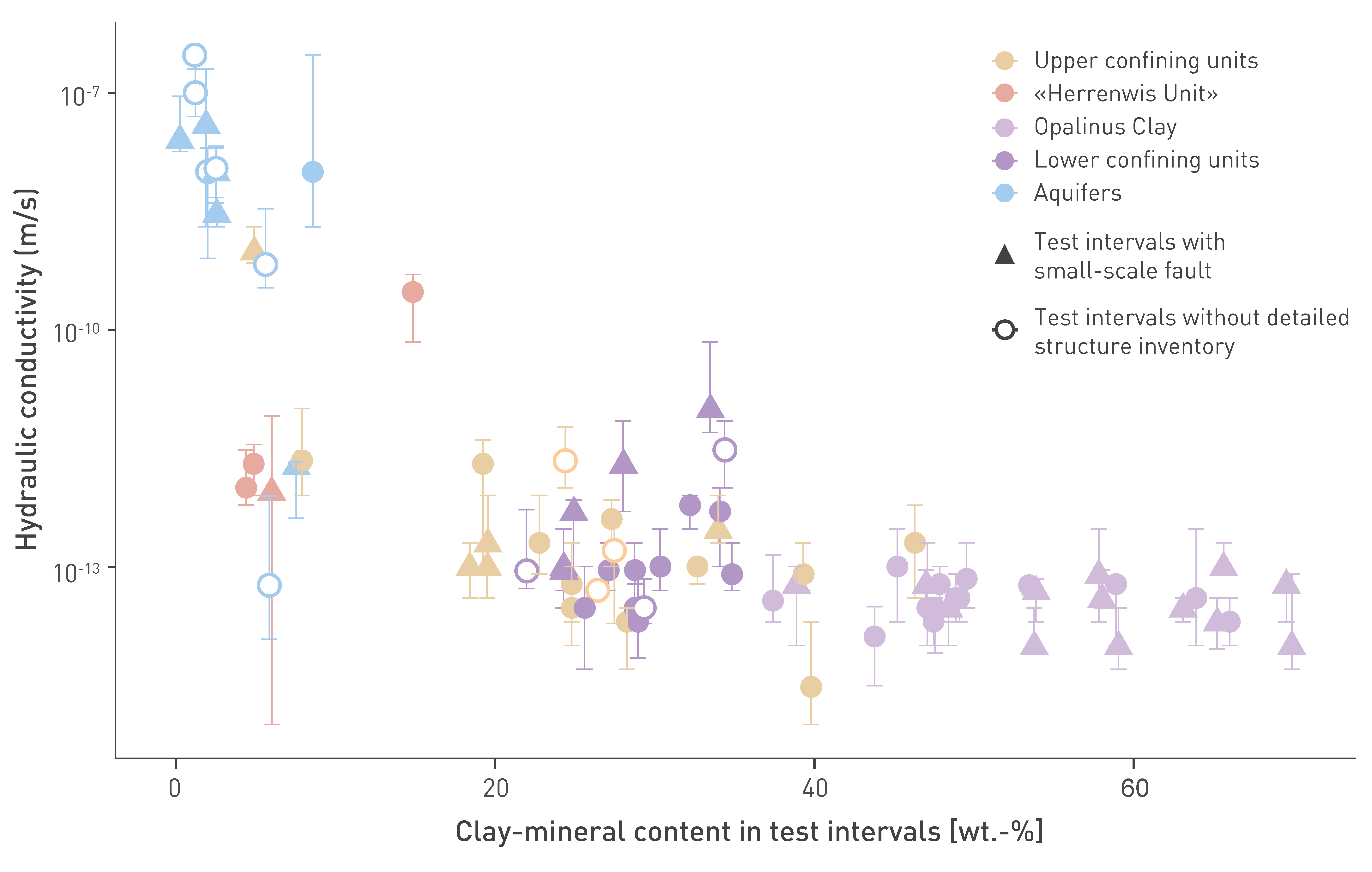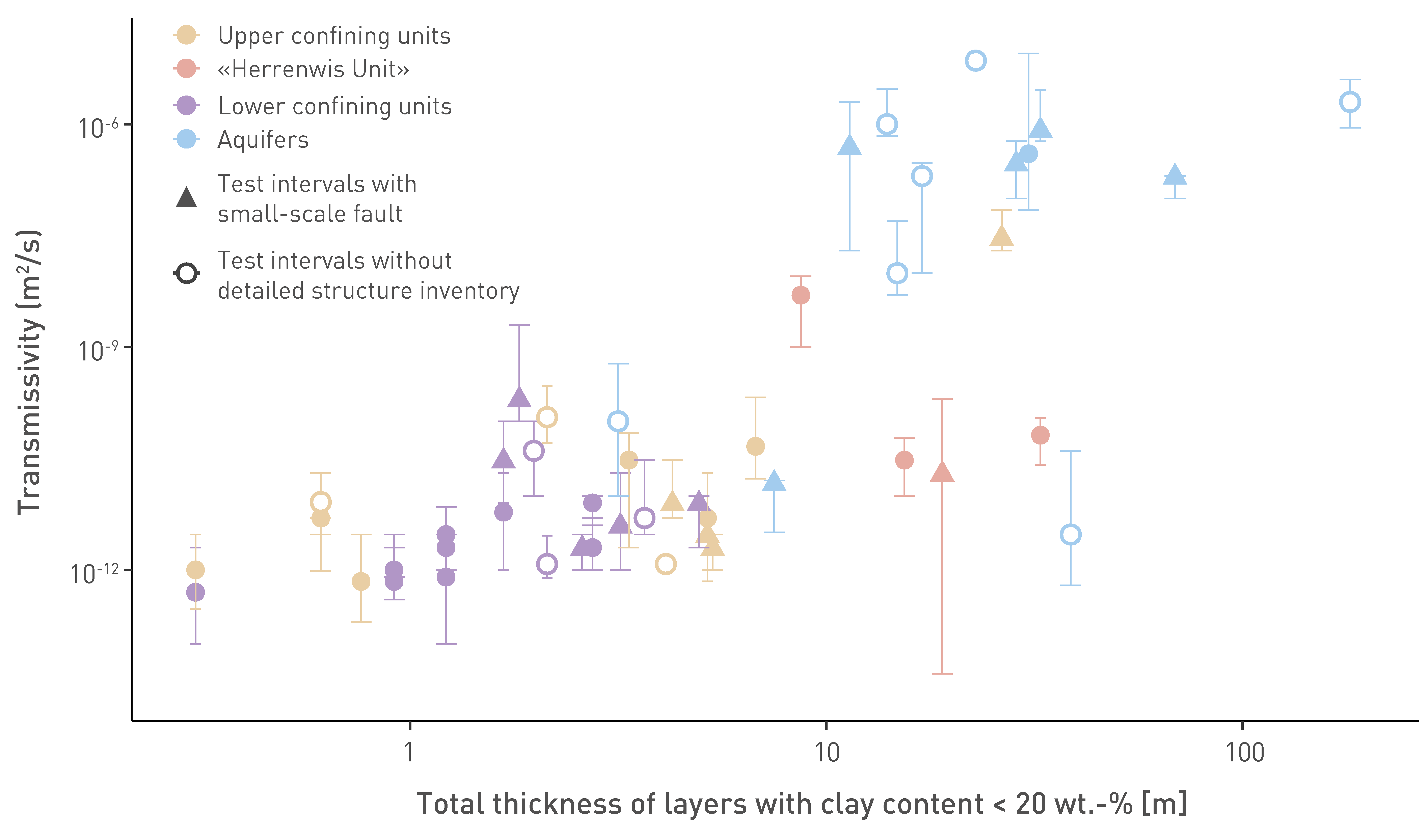A major effort was invested in the hydraulic characterisation of the confining units (see also Section 4.5.3). The in-situ hydraulic packer tests generally indicate hydraulic conductivities below 10-11 m/s and typical values around 10-13 m/s. The investigations do not provide evidence of significantly elevated matrix hydraulic conductivities in the confining units adjacent to the Opalinus Clay (Fig. 5‑37, Nagra 2024m). Therefore, the focus is on constraining the impact of fractures for different lithologies. As in previous reports (e.g. Nagra 2014f), the clay-mineral content of the units is used as a proxy for brittle behaviour and self-sealing potential and thus as an additional argument to constrain the hydraulic properties. This is done in two empirical approaches:
-
Evaluation of the hydraulic conductivity as a function of the clay-mineral content of the test interval: Given the lithological variability within the typical test intervals in the confining units, the data are displayed as a function of the lowest average clay-mineral content calculated over a 5 m window in the test intervals (Fig. 5‑42).
-
Evaluation of the hydraulic properties as a function of the thickness of the brittle, clay-poor units (i.e. clay-mineral content < 20 wt.-%; Fig. 5‑43).

Fig. 5‑42:Hydraulic conductivity of the in-situ hydraulic packer tests as a function of the clay-mineral content of the test interval
The dataset includes packer tests from the base of the Lias Group to the top of the Malm Group in the TBO boreholes plus RIN, WEI and BEN. The dataset for the confining units is supplemented by data from the Malm and Hauptrogenstein aquifers. See text regarding calculation of clay-mineral content.
The highest hydraulic conductivity (1 × 10-9 m/s) encountered in the upper confining units was measured in the Wildegg Formation of the BOZ1 borehole. This test interval includes the Gerstenhübel Bed. A hydraulic conductivity of 3 × 10-10 m/s was measured in the «Herrenwis Unit» of the STA2 borehole in association with a subvertical joint.
The hydraulic test results show a good correlation with the clay-mineral content (Fig. 5‑42):
-
Intervals with clay-mineral contents above about 35 – 40 wt.-% have consistently low hydraulic conductivities – similar to the Opalinus Clay – of < 10-13 m/s, demonstrating that the variable tectonic overprint is not associated with elevated transmissivities. This group corresponds not only to the Opalinus Clay but also to clay-rich formations in the upper confining units such as the «Parkinsoni-Württembergica-Schichten» or the clay-rich facies of the Wedelsandstein Formation in NL.
-
Intervals with a minimum average clay-mineral content in the range of ca. 20 – 40 wt.-% are characterised by a somewhat larger scatter, while hydraulic conductivities remain in majority below 10-11 m/s, even for tests with tectonic overprint. This indicates a reduced but relevant self-sealing potential. The presence of thin hard beds in some test intervals has no visible impact on the measured transmissivities (Fig. 5‑43), reflecting their small fracture inventory and low porosities. In summary, units corresponding to this group with a minimum clay-mineral content of 20 wt.-% contribute significantly to the hydraulic barrier effect. This group comprises the majority of packer test intervals of the upper confining units (with the exception of the «Herrenwis Unit» and the Wildegg Formation) and all the tests in the lower confining units.
-
The group with minimum average clay-mineral contents below 20 wt.-% shows a broad range of hydraulic conductivities. Values greater than ca. 10-9 m/s refer to tests with a thickness of the clay-poor section of more than ca. 8 m (Fig. 5‑43). This latter group includes the Malm and Hauptrogenstein aquifers, fractured intervals of the «Herrenwis Unit» and the Wildegg Formation (e.g. Gerstenhübel Bed). In contrast, test intervals with thinner clay-poor layers display average hydraulic conductivities below 10-11 m/s (Fig. 5‑43) even in the presence of small-scale faults.

Fig. 5‑43:Transmissivity as a function of the total thickness of a layer with clay-mineral content < 20 wt.-%
The dataset considered includes packer tests from the base of the Lias Group to the top of the Malm Group (except the Opalinus Clay) in the TBO boreholes plus RIN, WEI and BEN. The dataset of the confining units is supplemented with data from the Malm and Hauptrogenstein aquifers.
The highest transmissivity (3 × 10-8 m2/s) encountered in the upper confining units was measured in the Wildegg Formation of the BOZ1 borehole. The test interval includes the Gerstenhübel Bed. A transmissivity of 5 × 10-9 m2/s was measured in the «Herrenwis Unit» of the STA2 borehole in association with a subvertical joint.

